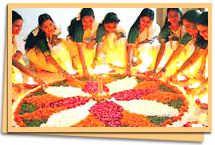
Rangoli is a very popular in the Indian subcontinent and is known by different names in different regions of India. It is called Alpana in Bengal, Aripana in Bihar, Madana in Rajasthan, Rangoli in Gujarat, Karnataka and Maharashtra, Chowkpurana in Uttar Pradesh, Kolam in the South Indian states of Kerala and Tamil Nadu and Muggu in Andhra Pradesh. While the power rangoli is more popular in the south Indian states, the North Indians prefer Alpana, which comprises of wet paint.
There are many folktales about the origin of the traditional art of rangoli in India. One such story traces its history to a legend recorded in the Chitralakshana, the earliest Indian treatise on painting. Long ago, the son of a renowned king's priest died. Lord Brahma, the creator of the universe, requested the king to make a painting of the boy so that he could turn him alive again. This is how the first rangoli was made. The motifs employed in making traditional Rangoli are usually inspired by nature and thus, consist of peacocks, flowers, humans, trees, etc.
Traditionally natural dyes like bark of trees, leaves, flower petals and turmeric powder were used to prepare Rangoli. However, these days, a number of colorful synthetic dyes have also come into the market. When a thin layer of the dye or the coloring material is used for making Rangoli, then the patterns look flat. A 3-D effect can be provided to the designs by using different sized grains like pulses, cereals, etc. Earlier such floor and wall decorations were done only on auspicious occasions.
However, today, any occasion, be it birthday, wedding or some other parties, etc, is good enough. You will also see rangoli almost everywhere in India during Diwali festival. The art form holds great religious significance. It also enhances the beauty of the surroundings and spreads joy and happiness all around. In Indian culture, our guests occupy a very special place and rangoli serves as an expression of this warm hospitality.

